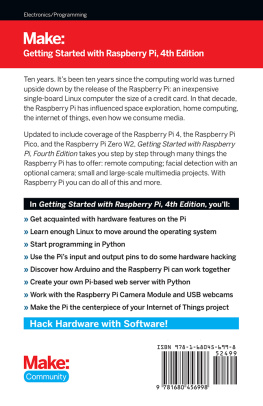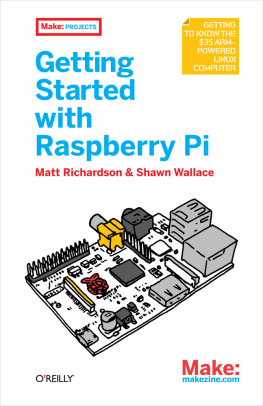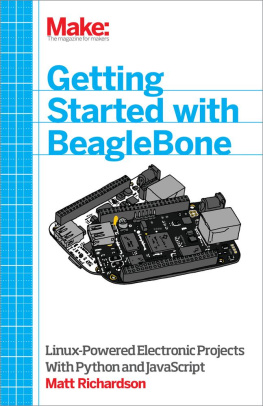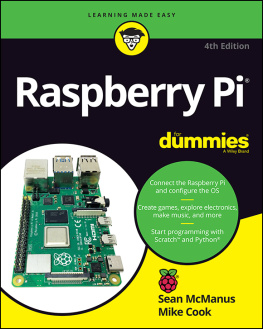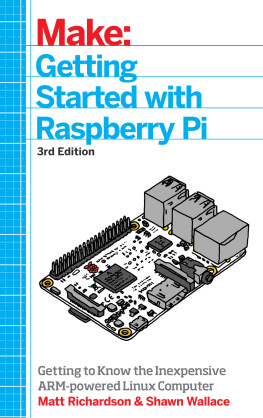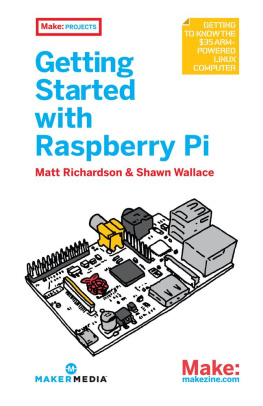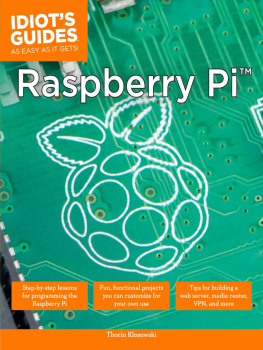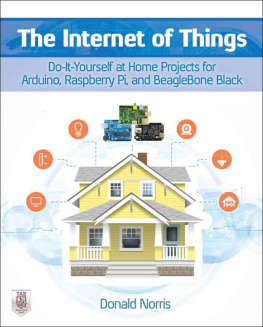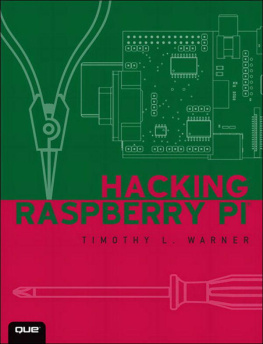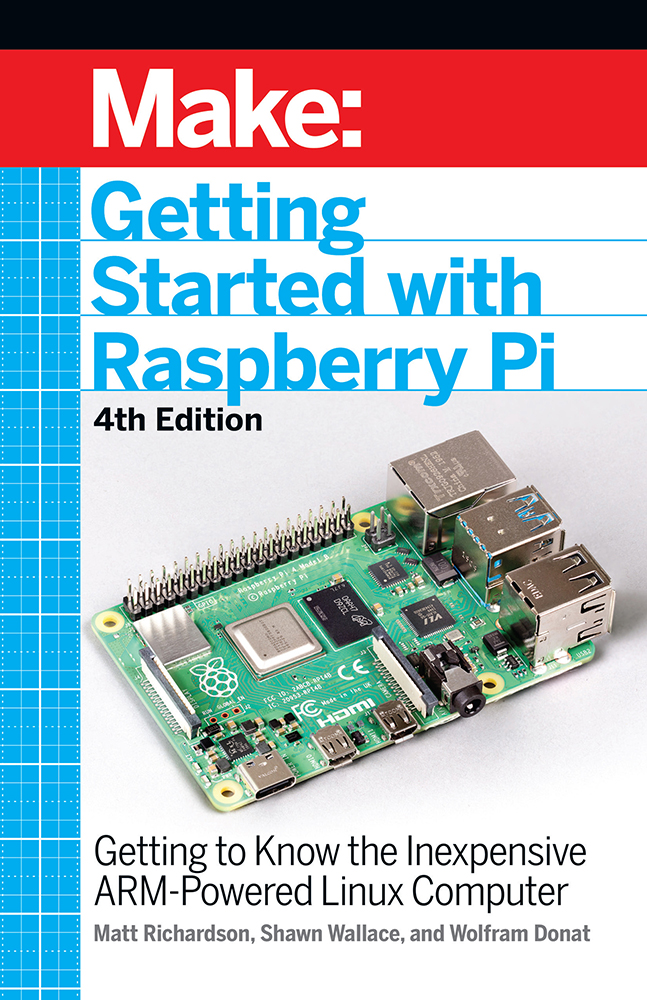Contents
Guide
Make:
Getting Started with Raspberry Pi
4TH EDITION
Getting to Know the Inexpensive ARM-Powered Linux Computer
Matt Richardson, Shawn Wallace, and Wolfram Donat
Make:
Getting Started with Raspberry Pi, 4th Edition
by Matt Richardson, Shawn Wallace, and Wolfram Donat
Copyright 2021 Matt Richardson, Shawn Wallace, and Wolfram Donat
Printed in the USA
Published by Make Community, LLC
150 Todd Road, Suite 100, Santa Rosa, CA 95407
Make: books may be purchased for educational, business, or sales promotional use. Online editions are also available for most titles.
For more information, contact our corporate/institutional sales department: 800-998-9938
Publisher: Dale Dougherty
Editor: Patrick DiJusto, Michelle Lowman
Copy Editor: Craig Couden
Interior Designer: David Futato
Cover Designer: Juliann Brown
Illustrator: Rebecca Demarest
December 2012: First Edition
October 2014: Second Edition
July 2016: Third Edition
September 2021: Fourth Edition
Revision History for the Fourth Edition: 10/29/2021
See www.oreilly.com/catalog/errata.csp?isbn=9781680456998 for release details.
Make:, Maker Shed, and Maker Faire are registered trademarks of Make Community, LLC. The Make: Community logo is a trademark of Make Community, LLC. Getting Started with Raspberry Pi and related trade dress are trademarks of Make Community, LLC. Many of the designations used by manufacturers and sellers to distinguish their products are claimed as trademarks. Where those designations appear in this book, and Make Community, LLC was aware of a trademark claim, the designations have been printed in caps or initial caps. While the publisher and the authors have made good faith efforts to ensure that the information and instructions contained in this work are accurate, the publisher and the authors disclaim all responsibility for errors or omissions, including without limitation responsibility for damages resulting from the use of or reliance on this work. Use of the information and instructions contained in this work is at your own risk. If any code samples or other technology this work contains or describes are subject to open source licenses or the intellectual property rights of others, it is your responsibility to ensure that your use thereof complies with such licenses and/or rights.
978-1-680-45699-8
OReilly Online Learning
For more than 40 years, www.oreilly.com has provided technology and business training, knowledge, and insight to help companies succeed.
Our unique network of experts and innovators share their knowledge and expertise through books, articles, conferences, and our online learning platform. OReillys online learning platform gives you on-demand access to live training courses, in-depth learning paths, interactive coding environments, and a vast collection of text and video from OReilly and 200+ other publishers. For more information, please visit www.oreilly.com
How to Contact Us:
Please address comments and questions concerning this book to the publisher:
Make: Community
150 Todd Road, Suite 100, Santa Rosa, CA 95407
Make: Community is a growing, global association of makers who are shaping the future of education and democratizing innovation. Through Make: magazine, and 200+ annual Maker Faires, Make: books, and more, we share the know-how of makers and promote the practice of making in schools, libraries and homes.
You can send comments and questions to us by email at .
To learn more about Make: visit us at make.co.
What Theyre Saying
about Getting Started with Raspberry Pi, 4th Edition
An exceptional introduction to the Raspberry Pi, accessible to a beginner and with in-depth references for experienced makers.Tim Wright, Aerospace Engineer
Im a kid from New York City. I thought the book was really helpful with the command line. I wanted to do some stuff with a project, but I was quite intimidated. Now that I read this book, I can set off!Kenji D., age 11.
Preface
Ten years.
Its been ten years since the Raspberry Pi was first announced in 2011. And what a decade it has been. A credit-cardsized computer for $35? That I can hook up to my existing monitor and keyboard setup? And connect to physical things via GPIO pins? It seemed like a pipe dream. This is why, when it started shipping, the Raspberry Pi created a frenzy of excitement.
Demand outstripped supply for months, and the waitlists for these mini computers were very long. Some of their newest products (and not-so-new) like the Pi Zero W and the Pi 4 still have limited availability; its difficult to find a place that will sell more than two Pi Zeros to a customer. Besides the price, what is it about the Raspberry Pi that tests the patience of this hardware-hungry mass of people? Before we get into everything that makes the Raspberry Pi so great, lets talk about its intended audience.
Eben Upton and his colleagues at the University of Cambridge noticed that students applying to study computer science didn t have the skills that they did in the 1990s. Students were considering themselves skilled at what they called computer science when all they could do was use MS Word and Excel and perhaps write a little HTML and perhaps JavaScript.
Upton and the others attributed this toamong other factors the rise of the home PC and games console to replace the Amigas, BBC Micros, Spectrum ZX, and Commodore 64 machines that people of an earlier generation learned to program on.
Because the computer has become important for every member of the household, it may also discourage younger members from tinkering around and possibly putting such a critical tool out of commission for the family. Parents dont want their children hacking the family computer while learning to program, because theyrun the risk of possibly breaking it.
Meanwhile, mobile phone and tablet processors had become less expensive while getting more powerful, clearing the path for the Raspberry Pis leap into the world of ultra-cheap-yet-serviceable computer boards. The ARM chip family thats used in all of the Pi boards got its main start inside mobile phones.
As Linus Torvalds, the founder of Linux, said in an interview with BBC News, the Raspberry Pi makes it possible to afford failure. If a child (or an adult) manages to brick the Pi, he or she can just buy another one, for far less than the cost of replacing a laptop.
Raspberry Pi Foundation
Its important to note that Raspberry Pi primarily exists to advance the charitable mission of the Raspberry Pi Foundation. That mission is to put the power of computing and digital making into the hands of people all over the world. The Raspberry Pi Foundation hopes that peoplekids especiallywill learn to code, learn how computers work, and learn how to make things with computers.
With every Raspberry Pi purchase you make, youre not only paying for the cost of the hardware, fulfillment, and the engineering behind it, youre also contributing the free online resources, free teacher training, and special programs that the Raspberry Pi Foundation offers to further its charitable mission.

